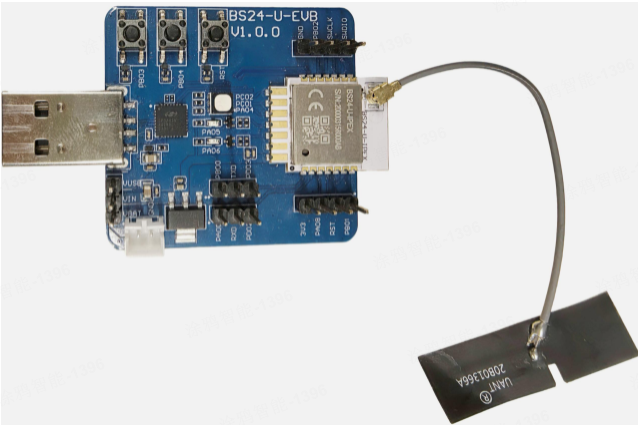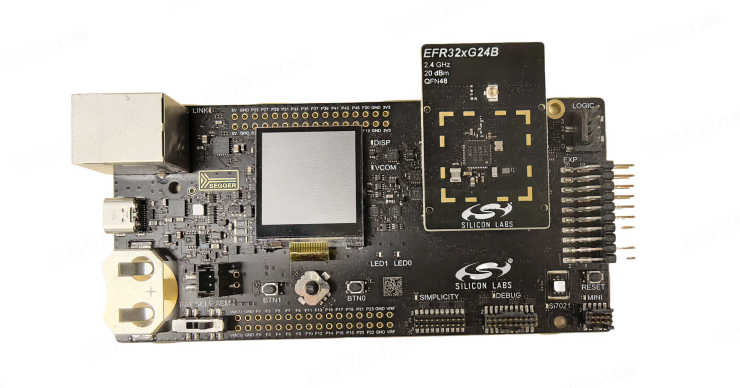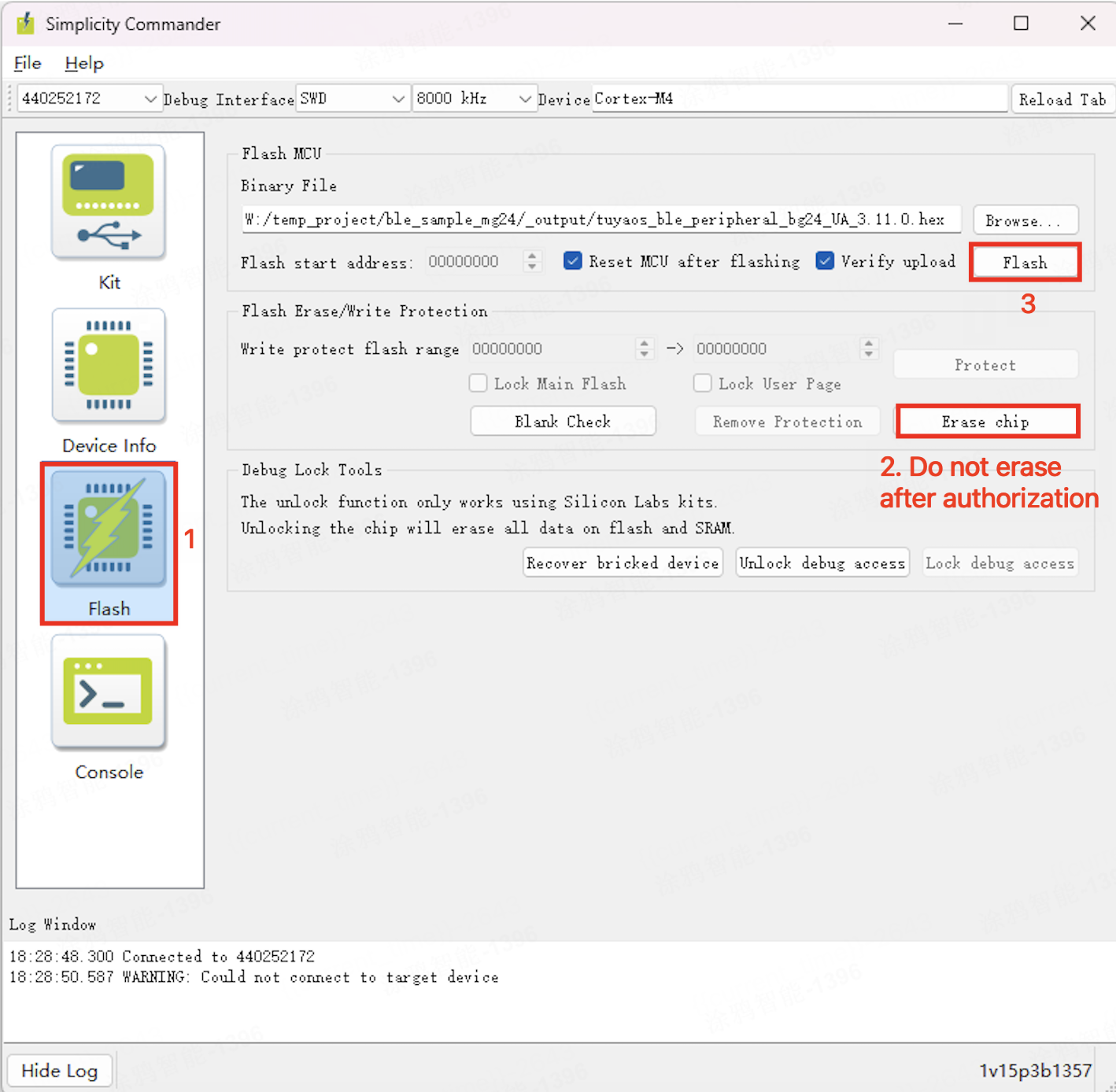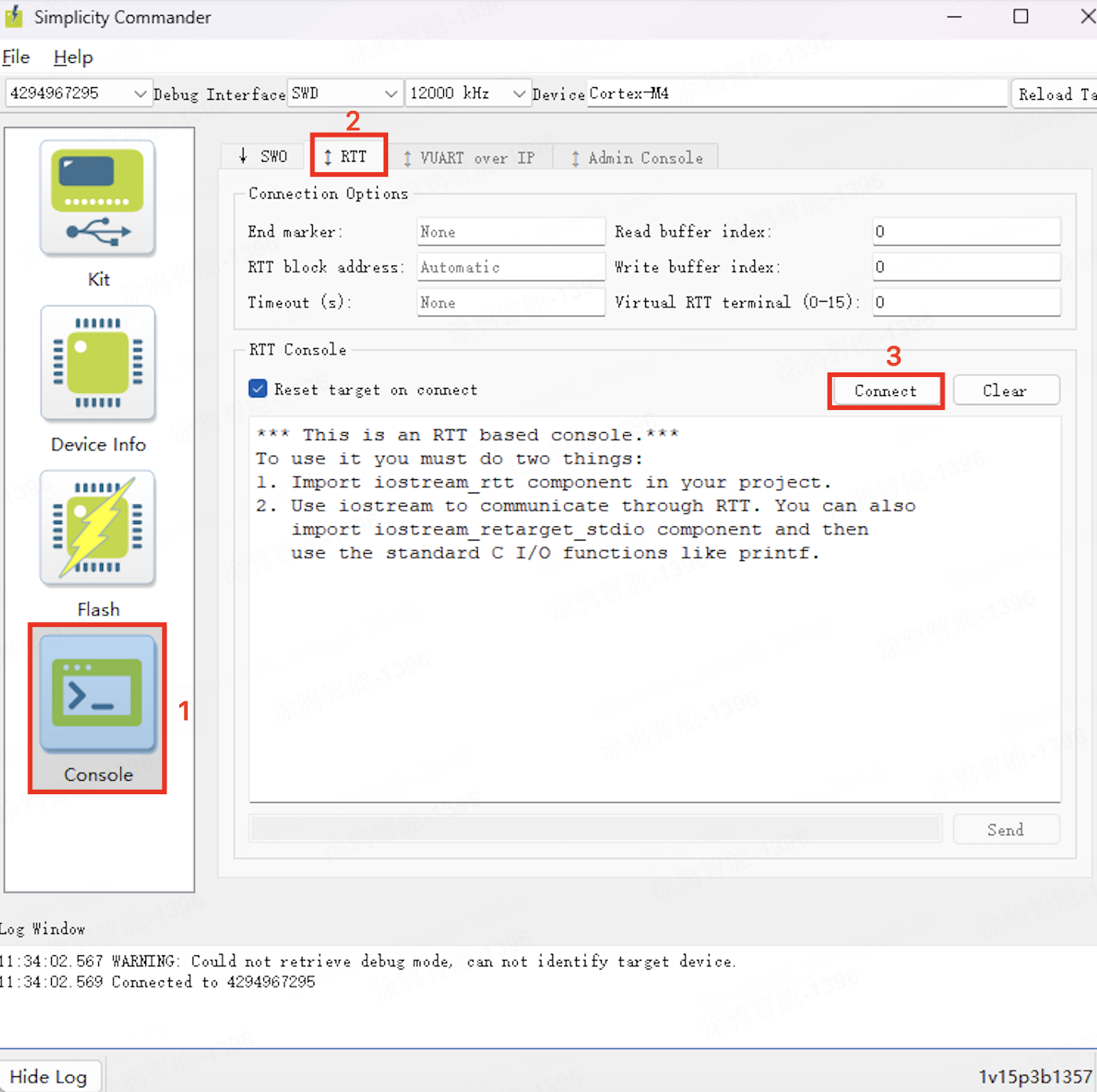Bluetooth LE-BG24
Last Updated on : 2025-05-14 02:03:49download
This topic describes the basics of the chip platform used in TuyaOS development. For more information, visit Tuya Developer Forum.
Hardware environment
Datasheet
- Method 1: After integrating the Bluetooth Sub-Device Development Framework, you can get the datasheet and reference manual in the
vendor\bg24_ble\documents\path. - Method 2: Visit the official website of Silicon Labs and get the latest information in the Documentation Center.
Development board
-
The following figure shows BS24-U-EVB:

-
The following figure shows the development board from the chip vendor:

Peripherals
Peripherals and corresponding GPIOs
- As the module does not require all pins to be exposed, GPIO multiplexing occurs within the SDK.
- You can customize pin assignments in
board_gpio.haccording to your specific application requirements.
GPIO
The SDK defaults to using the EFR32BG24A020IM40 chip model. All peripheral descriptions below are based on this chip. To change to a 48-pin package, define BOARD_GPIO_MAX to 48 in the app_config.h file.
To operate a specific I/O in TuyaOS, you need to specify its pin number in the input parameter. For the BG24 series chip platform, the table below shows the mapping between GPIO numbers and physical I/O pins:
QFN40
| GPIO No. | Pin | GPIO No. | Pin |
|---|---|---|---|
| TUYA_GPIO_NUM_1 | PC00 | TUYA_GPIO_NUM_2 | PC01 |
| TUYA_GPIO_NUM_3 | PC02 | TUYA_GPIO_NUM_4 | PC03 |
| TUYA_GPIO_NUM_5 | PC04 | TUYA_GPIO_NUM_6 | PC05 |
| TUYA_GPIO_NUM_7 | PC06 | TUYA_GPIO_NUM_8 | PC07 |
| TUYA_GPIO_NUM_16 | PB04 | TUYA_GPIO_NUM_17 | PB03 |
| TUYA_GPIO_NUM_18 | PB02 | TUYA_GPIO_NUM_19 | PB01 |
| TUYA_GPIO_NUM_20 | PB00 | TUYA_GPIO_NUM_21 | PA00 |
| TUYA_GPIO_NUM_24 | PA03 | TUYA_GPIO_NUM_25 | PA04 |
| TUYA_GPIO_NUM_26 | PA05 | TUYA_GPIO_NUM_27 | PA06 |
| TUYA_GPIO_NUM_28 | PA07 | TUYA_GPIO_NUM_29 | PA08 |
| TUYA_GPIO_NUM_37 | PD03 | TUYA_GPIO_NUM_38 | PD02 |
| TUYA_GPIO_NUM_39 | PD01 | TUYA_GPIO_NUM_40 | PD00 |
QFN48
| GPIO No. | Pin | GPIO No. | Pin |
|---|---|---|---|
| TUYA_GPIO_NUM_1 | PC00 | TUYA_GPIO_NUM_2 | PC01 |
| TUYA_GPIO_NUM_3 | PC02 | TUYA_GPIO_NUM_4 | PC03 |
| TUYA_GPIO_NUM_5 | PC04 | TUYA_GPIO_NUM_6 | PC05 |
| TUYA_GPIO_NUM_7 | PC06 | TUYA_GPIO_NUM_8 | PC07 |
| TUYA_GPIO_NUM_9 | PC08 | TUYA_GPIO_NUM_10 | PC09 |
| TUYA_GPIO_NUM_18 | PB05 | TUYA_GPIO_NUM_19 | PB04 |
| TUYA_GPIO_NUM_20 | PB03 | TUYA_GPIO_NUM_21 | PB02 |
| TUYA_GPIO_NUM_22 | PB01 | TUYA_GPIO_NUM_23 | PB00 |
| TUYA_GPIO_NUM_26 | PA00 | TUYA_GPIO_NUM_27 | PA01 |
| TUYA_GPIO_NUM_28 | PA02 | TUYA_GPIO_NUM_29 | PA03 |
| TUYA_GPIO_NUM_30 | PA04 | TUYA_GPIO_NUM_31 | PA05 |
| TUYA_GPIO_NUM_32 | PA06 | TUYA_GPIO_NUM_33 | PA07 |
| TUYA_GPIO_NUM_34 | PA08 | TUYA_GPIO_NUM_35 | PA09 |
| TUYA_GPIO_NUM_43 | PD05 | TUYA_GPIO_NUM_44 | PD04 |
| TUYA_GPIO_NUM_45 | PD03 | TUYA_GPIO_NUM_46 | PD02 |
| TUYA_GPIO_NUM_47 | PD01 | TUYA_GPIO_NUM_48 | PD00 |
PWM
By default, there are five PWM channels, occupying three channels of Timer0 and two of Timer1. Both Timer0 and Timer1 are 32-bit timers.
| Channel | Pin |
|---|---|
| 0 | PC01 |
| 1 | PC02 |
| 2 | PA04 |
| 3 | PA05 |
| 4 | PA06 |
UART
The system defaults to using two UART groups, with UART0 mapped to USART0 and UART1 mapped to EUSART0. The EUSART (only two groups available) can be multiplexed as SPI, UART, or card reader interfaces. Here, only its UART functionality is utilized.
| UART | Feature | Pin | Remarks |
|---|---|---|---|
| UART0 | TX | PD03 | Authorization and testing |
| UART0 | RX | PD02 | - |
| UART1 | TX | PA00 | Demo not used |
| UART1 | RX | PB00 | - |
SPI
| SPI | Feature | Pin |
|---|---|---|
| SPI0 | CS | PC00 |
| SPI0 | CLK | PC03 |
| SPI0 | SDI | PA00 |
| SPI0 | SDO | PB00 |
ADC
The chip supports 16 input channels, each of which can be configured as positive input (posInput) and negative input (negInput) modes. By default, negInput is connected to ground (GND, suitable for single-ended sampling). All I/Os of PAx, PBx, PCx, and PDx can be mapped to the input ports of IADC. They can be configured as single-channel sampling or multi-channel auto-scanning sampling mode.
By default, the SDK only supports one ADC to optimize resource usage. For additional channels, you can configure them by yourself.
| Channel | Pin |
|---|---|
| 0 | PB02 |
I2C
| I2C | Feature | Pin |
|---|---|---|
| IIC0 | SCL | PB01 |
| IIC0 | SDA | PB02 |
Key control
PB04:
- Press the key to wake up the device.
- Press and hold the key for three seconds to factory reset the device.
Power LED
PA08: Used for power-on time detection. It is set to high level after entering the main function.
Power consumption description
-
Broadcasting at 100 ms intervals results in approximately 2.5 mA typical power consumption.
-
Low-power broadcasting at 100 ms intervals consumes approximately 320 μA in EM2 mode.
-
By default, 1-second interval broadcasting consumes approximately 35 μA.
-
Without broadcasting, the EM2 power consumption is approximately 3.2 μA.
For more information, see vendor\bg24_ble\documents\bg24_QA.md.
Software environment
-
Make sure the
makecommand line tool has been installed in the environment, or search and installmake, configure the environment variables, and compile again. -
The SDK includes the pre-packaged Commander CLI tool (for flashing and log output), located at
vendor/bg24_ble/toolchain/software/commander. -
The toolchain is integrated into the SDK, so you do not need to download the toolchain again.
Flashing environment
-
Flash and erase: Click in the order shown below to perform the flash and erase operations.

-
Logging system (RTT): Click in the order shown below to view the software running log and get debugging information.

Bluetooth LE-BG24 SDK
-
Flash memory allocation
The allocated application region is 352 KB, with approximately 270 KB actually utilized.

-
SDK configuration
For more information on setting up the onboard GPIOs, be sure to refer to the documentation.
-
Flash memory allocation configuration
For flash memory allocation settings, refer to the document
bg24_flash.mdlocated atvendor/bg24_ble/documents.
Is this page helpful?
YesFeedbackIs this page helpful?
YesFeedback





